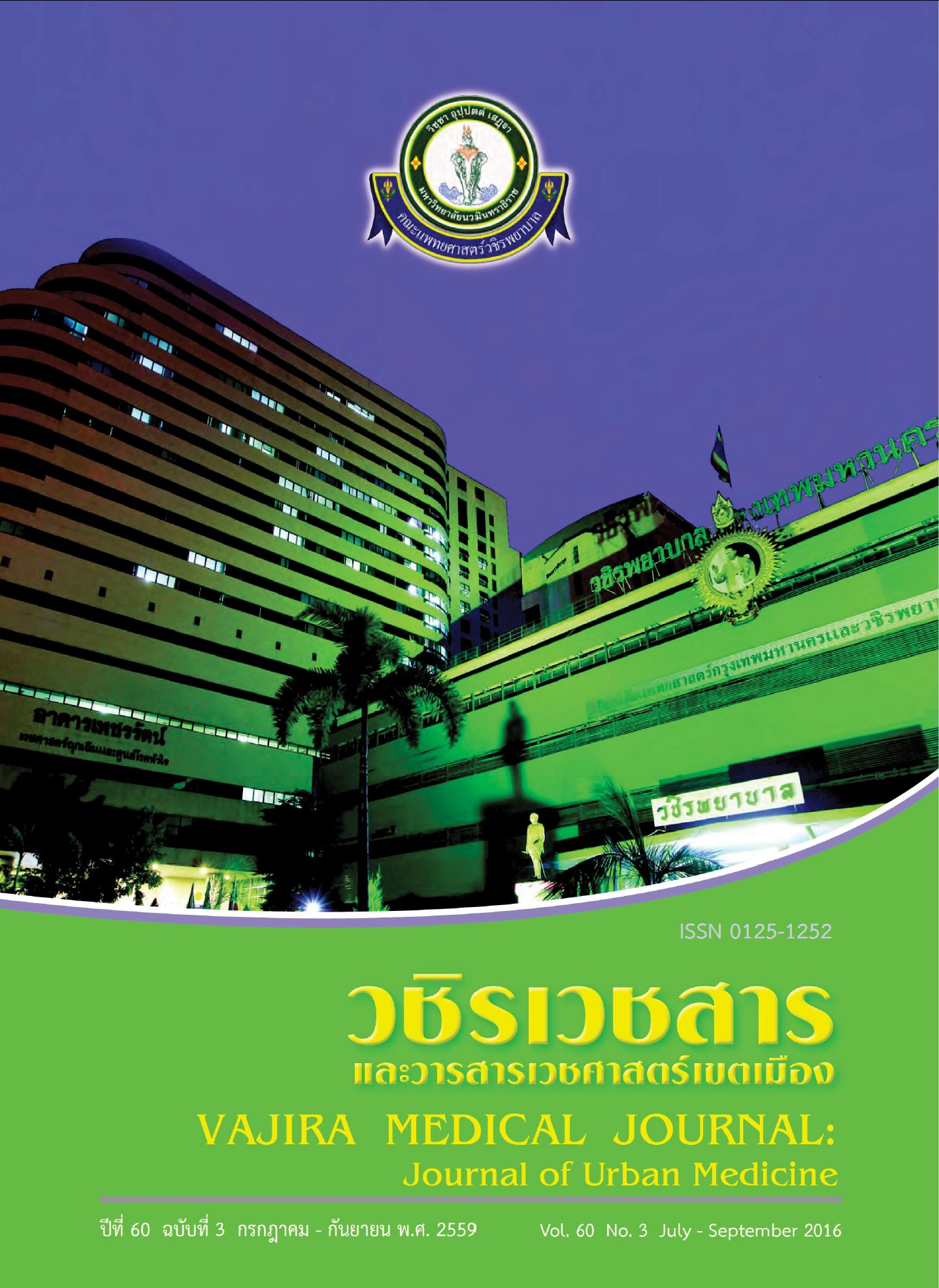Incidence of Ventilator-associated Pneumonia in Intensive Care Unit, Faculty of Medicine, Vajira Hospital
Main Article Content
Abstract
Objective: To evaluate the incidence and risk factors of ventilator-associated pneumonia (VAP) in intensive care unit (ICU) patient in the Faculty of Medicine, Vajira Hospital.
Methods: This study was a retrospective descriptive study. The sample group was 1,167 patients in ICU of Faculty of Medicine Vajira Hospital, who received mechanical ventilation from 1st October, 2011 to 30th September, 2012. Data were collected by surveillance form of Infection control division. The diagnosis of VAP was based on healthcare associated infection of Center for disease control and prevention (CDC) to evaluate the incidence and risk factors of VAP in ICU patient in the Faculty of Medicine Vajira Hospital.
Result: From all the 1,167 participants, 38 episodes of VAP developed. The incidence of VAP was 5.1 per 1,000 ventilator days. The most frequent incidence of 57.9% occurred in female and 86.8% was over 60 years of age. There were 65.8% of patients who had preexisting underlying disease, of which 76% was diabetes. Additionally, 92.1% of them received GI bleeding preventive drugs, of which 55.3% was omeprazole. Likewise, 26.3% received steroid and 31.6% on sedative drugs. Intubations were performed orally in 71.1%. Most of these intubations were performed on general ward (39.5%) and were re-intubation (10.5%). There were 33.7 days mean length to those under ventilators who had received mechanical ventilation for more than 7 days before acquiring pneumonia by 63.2%. Patients receiving antibiotics before acquiring pneumonia was 92.1%. The causative organisms of VAP called Acinetobacter baumanii was carbapenem drug resistant with 39.5% against other types of organisms found in the process of administration. On this study, the mortality rates of VAP in ICU patients in the Faculty of Medicine at Vajira Hospital were 36.8%.
Conclusion: The incidence of VAP at the ICU of the Faculty of Medicine, Vajira Hospital from 1st October, 2011 to 30th September, 2012 was 5.1 per 1,000 ventilator days with a mortality rates of 36.8%
Downloads
Article Details
References
2. George DL. Nosocomial pneumonia. In: Mayhall CG, editor. Hospital Epidemiology and Infection Control. Baltimore: Williams & Wilkins; 1996. p.175-95.
3. Richards MJ, Edwards JR, Culver DH, Gaynes RP. Nosocomial infections in combined medicalsurgical intensive care units in the United States. Infect Control Hosp Epidemiol. 2000; 21: 510-5.
4. Petdachai W. Ventilator-associated pneumonia in a newborn intensive care unit. Southeast Asian J Trop Med Public Health. 2004; 35: 724.
5. Rakshit P, Nagar VS, Deshpande AK. Incidence, clinical outcome and risk stratification of ventilator-associated pneumonia: a prospective cohort study. Indian J Crit Care Med. 2005; 9: 211-6.
6. Thongpiyapoom S, Narong MN, Suwalak N, Jamulitrat S, Intaraksa P, Boonrat J, et al. Device-associated infections and patterns of antimicrobial resistance in a medical-surgical intensive care unit in a university hospital in อุบัติการณ์การเกิดปอดอักเสบที่สัมพันธ์กับการใช้เครื่องช่วยหายใจในหออภิบาลคณะแพทยศาสตร์วชิรพยาบาล 209 ชายวุฒิ สววิบูลย์ ดุษฎี ดวงมณี เพ็ญศิริ แกล้วกสิกิจ รพีพรรณ จันทนลาช ศลิษา สืบคล้าย Vol. 60 No. 3 July – September 2016 Vajira Medical Journal: Journal of Urban Medicine Thailand. J Med Assoc Thai. 2004; 87: 819-24.
7. Unahalekhaka A, Jamulitrat S, Chongsuvivatwong V, Ovretveit J. Using a collaborative to reduce ventilator-associated pneumonia in Thailand. Jt Comm J Qual and Patient Saf. 2007; 33: 387-94.
8. Wilson J. Infection Control in clinical Practice. London: Bailliere Tindall; 1995. p.231-45.
9. Horan TC, Andrus M, Dudeck MA. CDC/NHSN surveillance definition of health care-associated infection and criteria for specific types of infections in the acute care setting. Am J Infect Control. 2008; 35:309-32.
10. Dudeck MA, Horan TC, Peterson KD, Bridson KA, Morrel G, Pollock DA. et al. National Healthcare Safety Network Report, Data Summary for 2010, Device-associated Module.
11. Kulvatuny N, Boonbarwornrattanakul A, Soonthornkit Y. et al. Incidence of Ventilator- Associated Pneumonia (VAP) After the Institution of an Educational Program on VAP Prevention. J Med Assoc Thai. 2007; 90 (1): 89-95.
12. Warren DK, Zack JE, Cox MJ, Cohen MM, Fraser VJ. An educational intervention to prevent catheter-associated bloodstream infections in a nonteaching, community medical center. Crit Care Med. 2003; 31: 1959-63.
13. Zack JE, Garrison T, Trovillion E, Clinkscale D, Coopersmith CM, Fraser VJ, et al. Effect of an education program aimed at reducing the occurrence of ventilator-associated pneumonia. Crit Care Med. 2002; 30: 2407-12.
14. Baker AM, Meredith JW, Haponik EF. Pneumonia in intubated trauma patients. Microbiology and outcomes. Am J Respir Crit Care Med. 1996; 153: 343-9.
15. Chastre J, Fagon JY. Ventilator-associated pneumonia. Am J Respir Crit Care Med. 2002; 165: 867-903.
16. Kollef MH. The prevention of ventilatorassociated pneumonia. N Engl J Med. 1999; 340: 627-34.
17. Haley RW, Culver DH, White JW, Morgan WM, Emori TG, Munn VP, et al. The efficacy of infection surveillance and control programs in preventing nosocomial infections in US hospitals. Am J Epidemiol. 1985; 121: 182-205.


